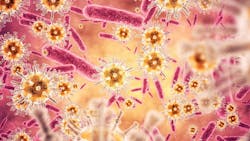LPS: Understanding the powerful immunomodulator in gram-negative bacteria
Lipopolysaccharides (LPS) are a central focus in the study of periodontal disease due to their presence on key gram-negative pathogens such as Porphyromonas gingivalis (Pg), Aggregatibacter actinomycetemcomitans (Aa), and Fusobacterium nucleatum (Fn). These molecules are potent immunomodulators, capable of triggering powerful inflammatory responses and making them major contributors to oral and systemic diseases.
However, not all LPS molecules are created equal.1 Their structural diversity and the immune evasion strategies employed by periodontal pathogens make them formidable drivers of chronic inflammation and tissue destruction.2
Structure of LPS molecules
LPS, also known as endotoxin, is a glycolipid composed of three primary regions: lipid A, core oligosaccharide, and the O-antigen. Each region plays a distinct role in bacterial virulence and immune activation.
The lipid A portion is the biologically active component of LPS and anchors the molecule to the bacterial outer membrane. It consists of a phosphorylated glucosamine disaccharide with multiple fatty acyl chains, which are hydrophobic, making the lipid A region resistant to water and a strong stimulator of inflammation. Lipid A interacts with toll-like receptor 4 (TLR4) on host immune cells, triggering the release of proinflammatory cytokines such as TNF-α, IL-1β, and IL-6 to amplify the immune response.1 Simply put, it’s a sugar with attached phosphate groups and several fatty “tails” that dislike water, keeping the LPS embedded in the bacterial membrane.
The core oligosaccharide region extends outward from lipid A and consists of a short chain of sugars. This region is relatively conserved among gram-negative bacteria and can be further divided into the inner core (closer to lipid A) and the outer core. Modifications to the core oligosaccharide can affect LPS interactions with host receptors, altering immune recognition and inflammatory potency.3
The O-antigen (O-polysaccharide) is a highly variable region composed of repeating oligosaccharide units. This structural diversity makes it an effective immune evasion tool. Different bacterial strains exhibit distinct O-antigen structures, helping them avoid immune detection. The O-antigen also contributes to bacterial resistance against complement-mediated killing, a key part of the host’s defense mechanism.4
Biosynthesis and immune activation
LPS biosynthesis, the process by which living organisms produce more complex molecules from simpler ones, is a complex, multistep process involving numerous genes and enzymes. During infection, LPS binds to TLR4 on the surface of immune cells, initiating a signaling cascade. This leads to the activation of NF-κB, a transcription factor responsible for driving the expression of proinflammatory cytokines.5
At low concentrations, LPS can prime the immune system and enhance host defense. However, in chronic or acute infections, excessive LPS exposure drives hyperinflammation, leading to tissue damage and systemic complications such as kidney and liver damage, platelet activation, acute respiratory distress syndrome, and septic shock.6
In the oral cavity, chronic LPS exposure contributes to periodontitis, stimulating the release of matrix metalloproteinases (MMPs), which degrade the extracellular matrix and periodontal ligament. LPS also promotes osteoclastogenesis, accelerating alveolar bone resorption and contributing to tooth loss.7
Immune evasion strategies of periodontal pathogens
Periodontal pathogens have evolved sophisticated mechanisms to avoid immune detection, ensuring their persistence in the oral cavity. These strategies include antigenic variation, immune decoys, and molecular mimicry, making them difficult to eradicate. Some pathogens frequently alter their surface antigens, including the O-antigen of LPS, making them harder for the immune system to recognize.
An example: Pg modifies its LPS structure to reduce recognition by TLR4, dampening the host’s inflammatory response and promoting chronic infection.8 Bacteria such as Aa produce polysaccharide capsules that cover their antigenic surface, shielding them from immune cells. This capsule prevents phagocytosis (cell engulfment), allowing the pathogen to evade immune clearance and persist in periodontal tissues. Certain pathogens like Treponema denticola (Td) express surface proteins that mimic host proteins, making them appear "self-like" to the immune system. This reduces immune responses, permitting the bacteria to evade detection.9
Pathogens can alter the sugar composition or length of the O-antigen, making it harder for the immune system to generate consistent antibodies. Fn expresses variable LPS forms, reducing its immune recognition and enabling it to act as a scaffolding bacterium; it easily binds to both early and late colonizers, promoting the coaggregation of mixed-species biofilms.10
Some pathogens, including Pg, release outer membrane vesicles (OMVs) packed with LPS and proteases. These vesicles act as decoys, drawing immune responses away from the bacterial cells themselves, which lets the pathogens survive and flourish.11
Pathogen-specific variability
While Pg is the most notorious periodontal pathogen due to its potent LPS, other gram-negative bacteria exhibit structural LPS differences that influence their virulence. Td lacks classic LPS and instead features a distinct glycolipid, which induces weaker inflammation than conventional LPS. This lets Td persist with reduced immune detection.9 Tannerella forsythia (Tf) possesses "rough-type" LPS, characterized by a less complex O-antigen, which reduces its immunogenicity compared to smoother LPS types.12
Prevotella intermedia (Pi) expresses low-potency LPS, which generates a milder immune response. This structural adaptation may enable Pi to evade stronger host defenses and persist in subgingival biofilms.13 Fn, while possessing LPS, is more notable for its coaggregation abilities. Fn’s LPS has relatively low inflammatory potency but enhances its role in biofilm formation and bacterial synergy, making it a keystone pathogen.10
Systemic implications of LPS
Chronic exposure to periodontal LPS can have systemic consequences. When LPS enters the bloodstream through diseased periodontal tissues, it contributes to low-grade systemic inflammation, a recognized risk factor for diseases like atherosclerosis, Type 2 diabetes, inflammatory bowel disease, and neurodegenerative diseases. Whether promoting endothelial dysfunction, disrupting insulin signaling pathways, blood brain barrier disfunction, and neuroinflammation, LPS leave a trail of destruction.2,8
LPS is a significant bacterial surface molecule that modulates host immunity. Its complex structure and immune evasion strategies by periodontal pathogens drive chronic inflammation and disease persistence. In periodontal disease, LPS causes local tissue destruction and increases systemic inflammation, linking it to wider health issues. To develop targeted therapies, we must understand the distinct LPS structures of different pathogens and their immune evasion strategies. Novel treatments aimed at neutralizing LPS toxicity or blocking TLR4 signaling hold promise in reducing the inflammatory burden of periodontal disease and its systemic consequences.
References
1. Fux AC, Casonato Melo C, Michelini S, et al. Heterogeneity of lipopolysaccharide as source of variability in bioassays and LPS-binding proteins as remedy. Int J Mol Sci. 2023;24(9):8395. doi:10.3390/ijms24098395
2. Santos WS, Solon IG, Branco LGS. Impact of periodontal lipopolysaccharides on systemic health: mechanisms, clinical implications, and future directions. Mol Oral Microbiol. 2025;40(3):117-127. doi:10.1111/omi.12490
3. Farhana A, Khan YS. Biochemistry, lipopolysaccharide. StatPearls Publishing. Updated April 17, 2023. https://www.ncbi.nlm.nih.gov/books/NBK554414
4. Garcia-Vello P, Di Lorenzo F, Lamprinaki D, et al. Structure of the O-antigen and the lipid A from the lipopolysaccharide of fusobacterium nucleatum ATCC 51191. Chembiochem. 2021;22(7):1252-1260. doi:10.1002/cbic.202000751
5. Murdock JL, Núñez G. TLR4: the winding road to the discovery of the LPS Receptor. J Immunol. 2016;197(7):2561-2562. doi:10.4049/jimmunol.1601400
6. Tang A, Shi Y, Dong Q, et al. Prognostic differences in sepsis caused by gram-negative bacteria and gram-positive bacteria: a systematic review and meta-analysis. Crit Care. 2023;27(1):467. doi:10.1186/s13054-023-04750-w
7. Yu B, Li Q, Zhou M. LPS‑induced upregulation of the TLR4 signaling pathway inhibits osteogenic differentiation of human periodontal ligament stem cells under inflammatory conditions. Int J Mol Med. 2019;43(6):2341-2351. doi:10.3892/ijmm.2019.4165
8. Banavar SR, Tan EL, Davamani F, Khoo SP. Periodontitis and lipopolysaccharides: how far have we understood? Explor Immunol. 2024;4:129-151. doi:10.37349/ei.2024.00133
9. Dashper SG, Seers CA, Tan KH, Reynolds EC. Virulence factors of the oral spirochete Treponema denticola. J Dent Res. 2011;90(6):691-703. doi:10.1177/0022034510385242
10. Chen Y, Huang Z, Tang Z, et al. More than gust a periodontal pathogen–the research progress on Fusobacterium nucleatum. Front Cell Infect Microbiol. 2022;12:815318. doi:10.3389/fcimb.2022.815318
11. Friedrich V, Gruber C, Nimeth I, et al. Outer membrane vesicles of Tannerella forsythia: biogenesis, composition, and virulence. Mol Oral Microbiol. 2015;30(6):451-473. doi:10.1111/omi.12104
12. Posch G, Andrukhov O, Vinogradov E, et al. Structure and immunogenicity of the rough-type lipopolysaccharide from the periodontal pathogen Tannerella forsythia. Clin Vaccine Immunol. 2013;20(6):945-953. doi:10.1128/CVI.00139-13
13. Kim SJ, Choi EY, Kim EG, et al. Prevotella intermedia lipopolysaccharide stimulates release of tumor necrosis factor-alpha through mitogen-activated protein kinase signaling pathways in monocyte-derived macrophages. FEMS Immunol Med Microbiol. 2007;51(2):407-413. doi:10.1111/j.1574-695X.2007.00318.x
About the Author

Anne O. Rice, BS, RDH, CDP, FAAOSH
Anne O. Rice, BS, RDH, CDP, FAAOSH, founded Oral Systemic Seminars after over 35 years of clinical practice and is passionate about educating the community on modifiable risk factors for dementia and their relationship to dentistry. She is a certified dementia practitioner, a longevity specialist, a fellow with AAOSH, and has consulted for Weill Cornell Alzheimer’s Prevention Clinic, FAU, and Atria Institute. Reach out to Anne at anneorice.com.


